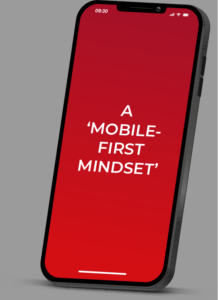We’re all familiar with the phrase “mobile first,” the digital shift that has led us to a world where people use their phones over any other device. The number of global Internet users has increased from 3 billion in 2018 to 4.77 billion today – that’s almost one-quarter (24 percent) of the world population! And according to Facebook’s latest estimations, there are 4.77 billion global mobile users – approximately one in every two people online are using a mobile device. With this new digital shift in mind, you should be taking a closer look at how to effectively reach audiences on their mobile devices.

A ‘mobile-first mindset’
A ‘mobile-first mindset’ means focusing on the experience of your audience and closely considering how they are engaging with your brand on smartphones and tablets or wearables. It means considering the use of voice search to find your brand. Content should be optimized for smaller screens and higher data speeds so it can load quickly. Web builds should consider the mobile screen over laptop, and be responsive to all device and browser types. And ad copy must keep in mind the mindset of a mobile user and the device on which it is served.
A ‘mobile-first mindset’
A ‘mobile-first mindset’ means focusing on the experience of your audience and closely considering how they are engaging with your brand on smartphones and tablets or wearables. It means considering the use of voice search to find your brand. Content should be optimized for smaller screens and higher data speeds so it can load quickly. Web builds should consider the mobile screen over laptop, and be responsive to all device and browser types. And ad copy must keep in mind the mindset of a mobile user and the device on which it is served.

It’s critical to keep in mind that all types of emerging technologies are being built with mobile-first as the baseline – think voice search or wearables like Fitbit, Apple Watch, or Google Glass.
Applying a Mobile First Mindset
When it comes to your audience’s mobile access to your brand, you need to approach creative strategy and content with insights into context, creative copy and images within ads. By doing so, you will be able to optimize any marketing campaign for maximum on-screen visibility and engagement.
To begin, let’s consider the user experience of someone who is using a mobile device. Consumers are increasingly accessing the internet on the go—thus often giving them less time (and perhaps less patience) than they would have at home or work. This means that if a website doesn’t load quickly enough, an ad is heavy with text, or making a purchase isn’t as frictionless as possible, you may lose potential customers who might’ve considered purchasing from you had they experienced your brand differently.
Mobile devices are also a major conduit for entertainment and information, so take advantage of this opportunity by creating video content that speaks directly to them on their phones—it will help build trust through interaction and establish an ongoing relationship between viewers and your brand. OTT and YouTube are great advertising positions for mobile users, and serving your own content there is a great way to augment your campaign.

Applying a Mobile First Mindset
When it comes to your audience’s mobile access to your brand, you need to approach creative strategy and content with insights into context, creative copy and images within ads. By doing so, you will be able to optimize any marketing campaign for maximum on-screen visibility and engagement.
To begin, let’s consider the user experience of someone who is using a mobile device. Consumers are increasingly accessing the internet on the go—thus often giving them less time (and perhaps less patience) than they would have at home or work. This means that if a website doesn’t load quickly enough, an ad is heavy with text, or making a purchase isn’t as frictionless as possible, you may lose potential customers who might’ve considered purchasing from you had they experienced your brand differently.
Mobile devices are also a major conduit for entertainment and information, so take advantage of this opportunity by creating video content that speaks directly to them on their phones—it will help build trust through interaction and establish an ongoing relationship between viewers and your brand. OTT and YouTube are great advertising positions for mobile users, and serving your own content there is a great way to augment your campaign.
Designing Ads For Digital
Most of Us Use More than One Device
When using a mobile-first mindset, it’s important to remember that most people have access to more than one device at any time. (For example: a smartphone while they commute and a tablet while hanging out at home, or a smartphone in-hand while watching streamed video content on a laptop or television.) As a result, it’s important to focus on what makes the most sense for each individual device as well as how these devices work together. Providing an optimal experience for users includes thoughtful delivery of content across the consumer’s eco-system, which includes where they are getting ads, but also whether the messaging or content served to them works best on their device.
Most of Us Use More than One Device
When using a mobile-first mindset, it’s important to remember that most people have access to more than one device at any time. (For example: a smartphone while they commute and a tablet while hanging out at home, or a smartphone in-hand while watching streamed video content on a laptop or television.) As a result, it’s important to focus on what makes the most sense for each individual device as well as how these devices work together. Providing an optimal experience for users includes thoughtful delivery of content across the consumer’s eco-system, which includes where they are getting ads, but also whether the messaging or content served to them works best on their device.
Next Step: Talk To Your Account Executive
A ‘mobile-first mindset’ means focusing on the experience of your audience and closely considering how they are engaging with your brand on smartphones and tablets or wearables. It means considering the use of voice search to find your brand. Are you set up for success, or thinking about how and where your audience is consuming your message? Your account executive can help you course correct, adjusting solutions to more fully engage your audience, if needed.

Contributed by Anne Drummond, Vice President of Marketing, Midwest


 Ad Choices
Ad Choices
